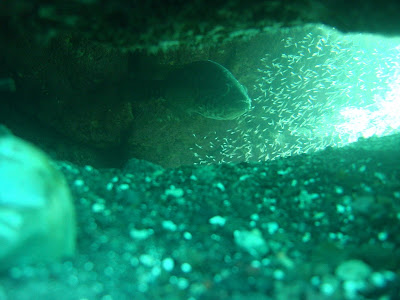-->
Many cichlid fish species evolved in the Nicaraguan Great Lakes system. Among the more popular of the fish of this region are the
guapotes, fish of the genus
Parachromis. Guapotes can make a very nice fish dinner. The most abundant of the
guapotes in the San Juan River and the Nicaraguan Great Lakes is the
Jaguar cichlid,
Parachromis managuensis. In Nicaragua, it is known as the
guapote barcino, in reference to its checkerboard spotted pattern. Along with
several species from the Midas cichlid species complex, the Jaguar cichlid make nests in which parental care observations can be made easily during SCUBA diving.
All the mating cichlids native to Nicaragua protect their young for several weeks after hatching. The guapotes have some important structural advantages to parental care over the more common Midas cichlids found in their range. First of all, the guapotes are large, and therefore can sustain large egg loads. It is not uncommon to see over 2000 fry at Jaguar cichlid nest. Secondly, the guapotes all have large mouths adapted to capture fast-swimming fishes. A bite of the Jaguar cichlid could be fatal even to a medium-sized fish. Potential predators know this and tend to avoid the risk of a bad bite.
 |
| These hatchling Jaguar cichlids are less than a week old. They stay near the parental units within reach of a natural or dug cave, and they receive parental care up to about 60 days after hatching. Photo by Martin Cabrera. |
Along with several bird species, the Jaguar cichlid sits atop the food web in Lake Apoyo, Nicaragua. It is the only fish in the lake that can kill and consume up to medium-size fish. Adult Jaguar cichlids only eat fish and perhaps crabs.
 |
| Hatchling P. managuensis are prone to move toward the diver, a camera, a hand. Photo by Martin Cabrera. |
Male Jaguar cichlids differ morphologically from females in its upturned mouth and other aspects of head shape. Like all the other cichlids native to Nicaragua, the males in breeding pairs always exceed the females in size.
 |
| This female Jaguar cichlid is never far from her free-swimming fry. Photo by Martin Cabrera. |
All cichlid nests can be fascinating, and the Jaguar cichlids are not unique in this respect. Parents may move little in defense of their fry, but they usually don't have to do much, to get the point across to potential predators.
 |
| Most cichlids in Nicaragua utilize natural features such as caves and holes to defend their offspring. This Jaguar cichlid is watching her fry just outside of this crevice. Photo by Martin Cabrera. |
Breeding seasonality of the Jaguar cichlid is not as strong as in the Midas cichlids in Lake Apoyo. Whereas the Midas cichlids may reproduce in only two to four months during the year, the Jaguar cichlid is found in reproduction most of the year.
 |
| A female Jaguar cichlid (P. managuensis) in her nesting site. Photo by Martin Cabrera. |
All
cichlid fishes in Nicaragua provide extensive parental care to their fry for the first several weeks after they hatch. There is fierce competition among the Jaguar cichlids for high-quality breeding sites such as this one in our photographs. This site is actually a cave under a large rock, with openings on both ends. The male parent of this nest has little or no continued relation with the nest, however. Big male
P. managuensis are scarce, and the males tend to abandon nests earlier than the female, in contrast with many other Nicaraguan cichlids. Big males are easily harpooned when on nest, and unscrupulous SCUBA divers often harvest this fish, as a trophy and for a great meal.
 |
| This female is emaciated from the physical stress and reduced food intake associated with reproduction. Photo by Martin Cabrera. |
Fry feed on detritus and phytoplankton/zooplankton. They stay close to their fellow fry at all times, depending on the maxim safety in numbers. Among the most dangerous predators of cichlid fry are the Bigmouth Sleepers (
Gobiomorus dormitor), introduced into Lake Apoyo only 22 years ago. Both adults and juveniles can catch cichlid fry, especially when a single fish has separated from the group. Fry face a much greater risk of capture when separated from their siblings.
 |
| Mother P. managuensis and her fry in Lake Apoyo, Nicaragua. Photo by Martin Cabrera. |
We at
FUNDECI/GAIA are working to determine the population structure of the fishes, plants and other life in Lake Apoyo, Nicaragua. This delicate lake is under tremendous pressure from people who want to do things that affect the lake: fish unsustainably, cultivate agricultural products using agrochemicals, build houses and install grassy gardens which use copious quantities of water and leave pollution in the lake. With a population baseline, we can determine variations in populations of the different fishes and plants which may result from human-induced alterations in the lake.
 |
| This female guapote barcino tends to thousands of fry. Photo by Martin Cabrera. |









No comments:
Post a Comment